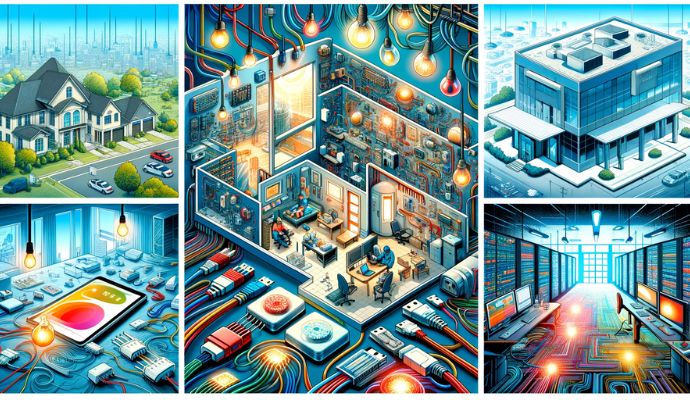Low Voltage Wiring: Safety, Efficiency, and Applications
Low voltage wiring plays a crucial role in powering various systems and devices in our modern world. From residential homes to commercial buildings, this specialized type of electrical wiring provides a range of benefits and functionalities. In this article, we will delve into the world of low voltage wiring, exploring its applications, advantages, and the industries that heavily rely on it.

Understanding Low Voltage Wiring
Low voltage wiring refers to electrical systems that operate at a voltage below 50 volts, typically between 12 and 24 volts. This type of wiring is commonly used to power various devices, systems, and appliances, offering a safer and more efficient alternative to standard high voltage wiring. Additionally, according to the International Electrotechnical Commission (IEC), low voltage is defined as voltage between 50 – 1,000 volts of alternating current and between 120 – 1,500 V of direct current. In the United States, the ANSI C84.1-2020 standard defines low voltage as 240 to 600 V.
Key Components of Low Voltage Wiring
Low voltage wiring systems consist of several essential components, including transformers, power supplies, cables, connectors, and control devices. Transformers are used to convert high voltage electricity to low voltage, while power supplies ensure a steady and reliable power source for the connected devices.
Benefits of Low Voltage Wiring
Low voltage wiring offers distinct advantages over high voltage systems, primarily enhancing safety by reducing electrical shock risks. Its lower voltage range allows for simpler and safer installations and maintenance, making it ideal for a variety of settings. These systems are also known for their energy efficiency, leading to notable cost savings and environmental benefits. Additionally, the flexibility in design and ease of scalability make low voltage wiring a versatile solution for both current and future applications, ranging from residential lighting to complex commercial infrastructures.

Uses of Low Voltage Wiring
Residential Applications
-Lighting Systems
Low voltage wiring is widely used in residential lighting systems. It enables the installation of versatile lighting designs, such as recessed lighting, track lighting, and accent lighting. The low voltage nature of these systems provides increased control, allowing homeowners to create personalized lighting atmospheres.
-Home Security Systems
Home security systems heavily rely on low voltage wiring to connect sensors, cameras, and alarms. This enables homeowners to monitor and protect their properties effectively. Low voltage wiring ensures seamless integration between various security components, offering enhanced security and peace of mind..
-Climate Control Systems
Low voltage wiring is also utilized in residential climate control systems, such as thermostats and HVAC (heating, ventilation, and air conditioning) systems. These systems regulate indoor temperature, providing comfort and energy efficiency. Low voltage wiring facilitates the communication between the control devices and the HVAC units.
Commercial Applications
-Office Buildings
In office buildings, low voltage wiring is essential for various applications, including lighting, security systems, and communication networks. It allows for the integration of different systems, enabling centralized control and monitoring. Low voltage wiring also supports the implementation of smart office technologies and energy management systems.
-Retail Stores
Retail stores utilize low voltage wiring for a range of purposes. It powers lighting displays, digital signage, cash register systems, and security systems. Low voltage wiring enables retailers to create appealing visual displays while ensuring the seamless operation of their sales and security systems.
-Data Centers
Data centers heavily rely on low voltage wiring for their complex infrastructure. It provides power distribution to servers, networking equipment, and cooling systems. The flexibility and scalability of low voltage wiring make it ideal for data centers, where reliability and efficiency are paramount.

Industrial Applications
-Manufacturing Facilities
Low voltage wiring is extensively used in manufacturing facilities to power machinery, production lines, and control systems. It ensures efficient communication between different components, facilitating smooth operations and optimized productivity. The low voltage nature of these systems minimizes the risk of electrical hazards in industrial environments.
-Power Plants
Power plants require intricate wiring systems to connect generators, transformers, and control devices. Low voltage wiring provides the necessary power distribution infrastructure within power plants, ensuring safe and reliable operation. It plays a critical role in maintaining uninterrupted power supply to the electrical grid.
-Warehouses
Warehouses utilize low voltage wiring for various purposes, including lighting, security systems, and material handling equipment. Efficient lighting systems powered by low voltage wiring enhance visibility and safety within the warehouse environment. Security systems help protect valuable inventory, while low voltage-powered equipment enables efficient logistics operations.
Low Voltage Wiring in the Automotive Industry
Low voltage wiring is vital in modern vehicles, powering systems like lighting, audio, climate control, and engine management. Integral to automotive innovation, it supports advanced features such as high-quality multimedia systems, automatic climate control, and sophisticated engine diagnostics. The automotive industry heavily relies on low voltage wiring for emerging technologies, including driver-assistance systems and the operation of electric and hybrid vehicles. This technology plays a crucial role in enhancing vehicle performance, efficiency, and user experience, marking a significant shift towards more intelligent and eco-friendly transportation solutions.

The future role and significance of low voltage wiring
The future of low voltage wiring is intrinsically linked to technological advancements, positioning it as a key driver in smart homes, electric vehicles, and renewable energy systems. It will play a crucial role in home automation, enhancing energy efficiency and control. In electric vehicles, low voltage wiring is essential for battery management and system controls, pivotal for vehicle performance. Additionally, its integration with renewable energy sources, especially in solar-powered systems, and the burgeoning Internet of Things (IoT) domain, underscores its importance in enabling a more interconnected, sustainable, and efficient future.
Low voltage wiring is a critical component of modern electrical systems, powering a wide range of applications across residential, commercial, and industrial sectors. Its numerous advantages, including safety, flexibility, and energy efficiency, make it an ideal choice for powering various devices and systems. As technology advances, we can expect low voltage wiring to continue shaping our connected world.
If you need any solution in the Network wiring or Low voltage realm like Access control, fire alarm, Fire sprinkler, Network Audio/Intercom, Audio & Video Solutions, Systems Integration of IP video, or any electronic security contact Low Voltage Houston.

